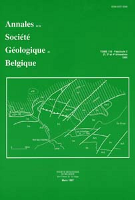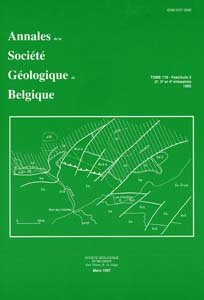- Accueil
- Volume 114 (1991)
- Fascicule 1 (Proceedings of the International Meet...
- Review of the Silurian in the Brabant Massif, Belgium
Visualisation(s): 725 (17 ULiège)
Téléchargement(s): 1113 (9 ULiège)
Review of the Silurian in the Brabant Massif, Belgium

Abstract
Literature on the Silurian of the Brabant Massif reveals considerable isolated data, mostly on stratigraphy. Own observations in the thick monotonous Silurian of the southern rim have resulted in a detailed lithostratigraphy (Mehaigne area, Sennette Valley, Orneau Valley, Western Flanders). The Llandovery to lower Ludlow sediments are more than 2850 m thick, and mostly turbidites with some intercalated laminated hemipelagites and bentonites. In the central and northern part of the Brabant Massif only a few boreholes have been drilled.
Macrofossils are rare but graptolites provide a good but incomplete coverage. By contrast the organic microfossils, Chitinozoa, have been separated in 80% of the samples. They underwent a very low grade metamorphism of the deep anchizone and estimated heating of over 200-250°C. The rather high frequency is explained by a substantial water depth of the source area of the turbidites, a favourable environment for Chitinozoa. From there they were transported with the sediments in the turbidity currents. A Chitinozoa biozonation in the Brabant Massif has as many zones/subzones as the graptolites.
The roughly E-W trending basin was filled by turbidite fan systems, with a remarkable lateral uniformity observed over several km in the middle and late Wenlock of the Mehaigne area and some lateral variation mainly by downcutting of palaeoflow (S-N), over a few hundreds of meters of distance, in the Gorstian at Ronquières.
Sedimentological, lithological or micropalaeontological cyclicities are observed on the metric, decametric and hectometric scale throughout the column. Some can be assigned to eustatic, regional or local influences. The Silurian sequence forms only a part of a major megacycle spanning the Upper Ordovician till Middle/Upper Devonian. Upper Ordovician sediments with several shallow, shelly and deep, euxinitic intervals are deposited contemporaneous with the most important Caledonian magmatic phase in the Brabant Massif. An ignimbritic event marks the end of explosive volcanism in the Rhuddanian. Turbiditic sedimentation starts shortly above the ignimbrite and continues until Prídolí. Middle or Upper Devonian unconformably covers the Brabant Massif and overlies the major observed Caledonian unconformity.
Data, mainly derived from available literature, is used to demonstrate several Caledonian phases as well as eustatic events within the Brabant Massif.
Pour citer cet article
A propos de : Jacques Verniers
Vrije Universiteit Brussel (KWAR), Pleinlaan 2, B-1050 Brussel, Research Associate N.F.S.R. (Belgium).
A propos de : Geert Van Grootel
Rijksuniversiteit Gent, Labo. voor Paleontologie, Krijgslaan 281, B-9000 Gent, Belgium.





